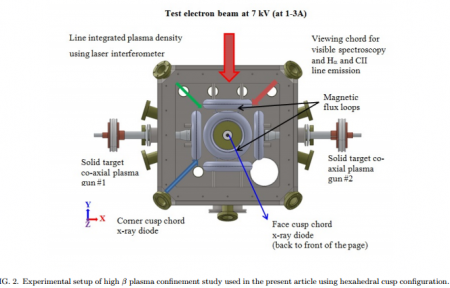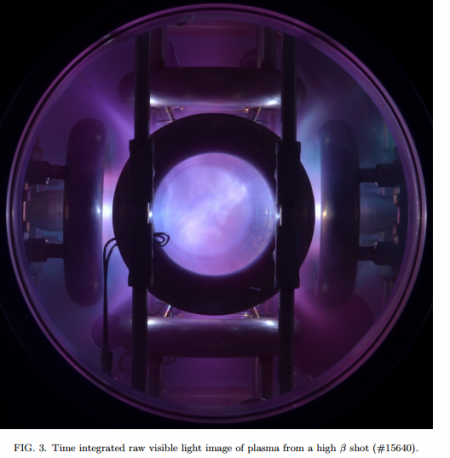Jun
10
Bussard’s Polywell Fusion Passes a Major Test
June 10, 2014 | 3 Comments
The paper simply reports experimental results validating the concept that plasma confinement is enhanced in a magnetic cusp configuration. Basically, the work and experiments take Dr. Bussard’s ideas to a new level with an experiment set that proves the theory to a higher energy level. It is welcome news, years in the making.
The Bussard reactor, named the wiffleball, gets it name from its appearance and diminutive size. It is a vastly different idea that the aircraft carrier (or perhaps larger) ITER idea based on the donut shaped tokamak.
Bussard’s idea is using a blend of electrostatic confinement where a set of magnetic fields hold the fuel and the polywell which is a cavity that forms inside the magnetic fields. Bussard’s idea relies on the highly energized and confined fuel to use its own energy seen in it speed to crash atoms together and fuse releasing the energy for us to use. That’s obviously way over simplified, but describes the idea so that the problem is easy to grasp as well.
With six magnets arranged to form a box a wiffleball reactor has corners. Its at the corners where the fuel and its energy can leak out, bleeding off the energy and fuel thus putting the reaction at risk for producing the needed energy.
Bussard’s idea isn’t the only one out there. Ideas include Dr. Lerner’s Focus Fusion effort, the magnetic pinch, stellarator, magnetic mirror, General Fusion’s physical compression and the ‘refuses to die’ tokamak. Plus many more. But the wiffleball has already produced fusion events.
The earlier wiffleballs leaked so much that the reactor couldn’t ever get to producing more power out than went in. But Dr. Bussard’s results encouraged many to offer that with enough energy and pressure against the magnetic field a sharp boundary would form between the magnetic fields and the plasma – so cutting the losses.
What the paper reports is validation of the boundary forming, which shows critical progress toward a polywell fusion reactor.
The EMC2 team built a test specific wiffleball reactor designed for proving up the anticipated boundary. The performed as expected and it seems to have survived thousands of test runs. The reactor was enclosed in a vacuum chamber, packed with measuring equipment and set to work.
What validates the experiment is the use of an electron beam and beam induced hard x-ray measurement to measure the confinement property. The chamber was also riddled with the test equipment wiring and the full kit of measuring devices.
As the reactor, chamber and test equipment made for a means to test the boundary the reactor wasn’t set up for testing fusion reactions. That reality disappointed many who for years now were hoping for the “Net Power” breakthrough.
What we know now is the new data demonstrate for the first time that high beta plasma operation can dramatically improve high energy electron confinement in the magnetic cusp system. This result validates the central premise of the polywell fusion concept which uses high energy beam injected electrons to create an electrostatic potential well for ion acceleration and confinement.
What stands out beyond the experiments results is the wiffleball idea is now verified using proper diagnostics.
Dr. Bussard was quite a physics innovator. His ideas ranged from space propulsion to local power. He was well regarded by many in his field and generated considerable controversy when his ideas stretched the imaginations of others. To have hard documented diagnostic data in hard should raise the capital to press on.
The wiffleball is admittedly one of your humble writer’s favorites. Inertial electrostatic confinement has been fusing for decades. Dr, Bussard’s genius was seeing how to create a polywell to build a reactor. A wiffleball is intuitively and logically correct.
A gigawatt coal or nuclear generating station is a huge installation, an equivalent photovoltaic facility covers even more ground, and enough wind turbines would deface and populate thousands of square miles. A gigawatt wiffleball reactor may well fit in a two car garage – not including the supporting equipment – but fuel for a few thousand dollars a year.
But there is a very long way to go. Each step discovers never before seen problems whose solutions are unique one of a kind engineering and manufacturing challenges.
The promise is so tempting, cheap grid power forever, vast power sources for ships, trains perhaps even trucks and infinite spacecraft power and propulsion. The effort is worth it, the risk is to change the course of history.
Comments
3 Comments so far




One of these fusion groups is going to achieve net power and turn the world on it’s head. Cheap, clean, inexhaustable power will be a paradigmn shift.
Suddenly, it will be economically possible to made freshwater from the sea and plant the desert. It will be economically feasible to pull carbon from the air and make gasoline.
I believe that someone already working on the problem will solve it in the next 5 years. Who knows – maybe several groups will achieve net power. But I would bet the farm that is will not be the ITER!
A GW plant will not fit in a garage. The reactor might. But the plant will not. Even if direct conversion works well (80% conversion to electricity) that 200 MW means a LOT of cooling.
[…] Bussard's Polywell Fusion Passes a Major Test EMC2 revives quest for nuclear fusion power The Polywell Blog Quote: […]